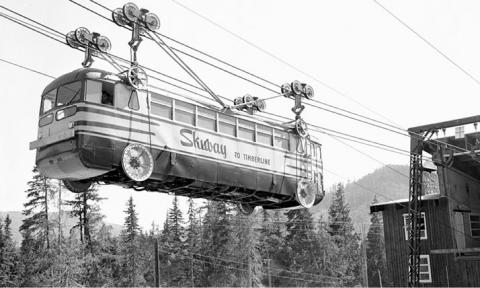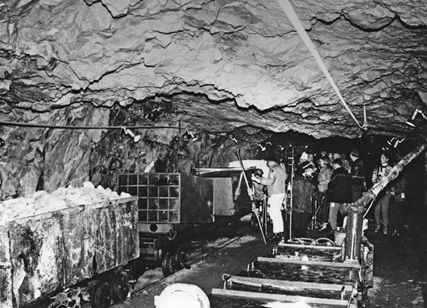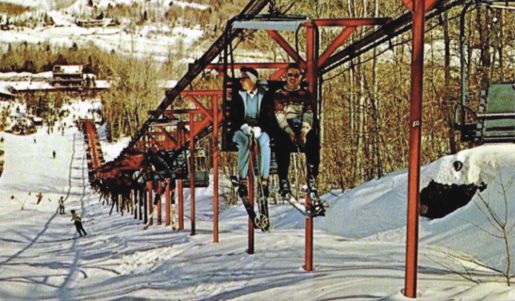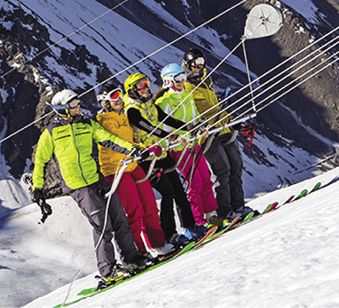
Ski lift evolution is dotted with failed experiments.
(Photo above: The Mount Hood Skiway launched in 1951. The enormous weight of the buses meant the lift hauled 72 skiers per hour—when a chairlift of that era transported 1,000.)
The new high-speed Jordan 8 bubble chairlift at Sunday River, Maine, will be the fastest eight-pack in North America once it’s installed for the 2022–23 ski season. Thirty-two hundred skiers per hour will ascend at 20 feet per second, cradled in heated seats with head and foot rests.
This Usain Bolt of lifts will be the ultimate in uphill transportation, and a far cry from America’s first surface lift—a steam-powered toboggan tow built in Truckee, California, in 1910. The article, “A History of North American Ski Lifts, by Mort Lund and Kirby Gilbert (Skiing Heritage, September 2003) tells the full story of how Alex Foster’s rope tow (1932–33) was succeeded by Ernst Constam’s J-bar and T-bar (1934), and then by Jim Curran’s chairlift (1936). That article traces the story of lift designs that were successful enough to become commonplace. But what about the lifts that didn’t make the Darwinian cut?
Skiers have been transported by devices that look strange to us today, including boat tows, ski-on gondolas, jigback trams, Air Cars, Skimobiles, shotgun tows and sit-sideways chairs. There have been city buses converted to skiways, attempts at monorail lifts and a greasy chain-drive contraption that ruined more than a few ski outfits.
“Consider the trials and tribulations of lift design through the years,” says Peter Landsman, a lift supervisor at Jackson Hole, Wyoming, who started LiftBlog.com in 2015. “People are passionate about skiing. Almost as long as there have been skiers, there have been people trying to determine the best and fastest and most efficient way to get to the top.”
Ski lift engineers have done their best to make the ascent a smooth one, but it didn’t always go as planned. Here are a few of the engineering dead-ends we can charitably consider “nice tries.”

mine hoists, Aspen's boat tow
opened in 1938. and hauled
skers, at 10 cents a ride, until
1946. Aspen Historical Society
Ahoy, Mateys!
Before its first chairlift, Aspen skiers relied upon repurposed mining equipment. The original Boat Tow on Aspen Mountain was constructed in 1937 by members of the Aspen Ski Club and opened on January 27, 1938. It consisted of two wooden toboggans, or “boats,” each one 12 feet long by three feet wide and containing four plank seats mounted rowboat style. The boats were constructed of pine, including the runners, which had steel banding attached, according to Aspenmod.com.
The boats were connected by steel cable to rotating terminals converted from hoist rigs that had been taken from the Little Annie Mine on Aspen Mountain. The cable was guided up the mountain by wood towers. The motor was a converted Model A Ford engine.
Up to eight people could sit in a boat and be pulled up 600 feet of vertical in less than three minutes, while the empty boat slid down the other side. The fee was 10 cents a ride, 50 cents for a half-day. The boat tow lasted through December 1946, when chairlifts were deemed a higher capacity—and preferred–route uphill.
Leave the Driving to Us
At least the name was impressive: Oregon’s Mount Hood Aerial Skiway. But, in reality, it was two repurposed city buses, each using a pair of 185-horsepower gasoline engines to ascend a stationary 1.5-inch diameter cable—a technology also used in timber operations to haul logs out of the woods, according to Lindsey Benjamin, writing for the Oregon Historical Society.
In January 1951, the Mount Hood Skiway opened, climbing 3.2 miles from below Government Camp to Timberline Lodge. It was the longest lift of its kind in the world and attracted the attention of newspapers, popular magazines and newsreel producers on its preview voyage. In an August 1951 Popular Science article, Richard Neuberger described the Skiway as the “most extraordinary of busses,” scraping clouds to deposit passengers at Timberline Lodge. A 1956 newsreel breathlessly exclaimed, “It flies through the air with the greatest of ease!”
Equipped with streetcar-style seats that flipped to allow passengers to always face forward, each bus had a capacity of 36 riders. When finally hung on the cables, the buses’ behemoth weight resulted in a 5.2–miles per hour, 25-minute trip up the mountain. Each round trip thus took an hour, which meant the Skiway lifted only 72 people per hour—in an era when the typical chairlift hauled 1,000 skiers in the same time frame.
Said Bill Keil, a Timberline Lodge publicity manager during the 1950s, “The tramway crippled its way through five years of marginal operations before suspending” in 1956. By June 1959, despite repeated efforts to carry out experiments for a redesign, a liquidating committee was formed. The lower terminal building was sold in 1960 for $25,000, and Zidell Machinery and Supply Company bought the two buses, a jeep, an engine and other tram parts for $10,080.
“I guess it proved to be not the most successful lift, but it certainly looked cool,” says LiftBlog.com’s Landsman.
It was an ignoble end. To see the Skiway in action, go to skiinghistory.org/resources/video/failure-mt-hood-skiway

in 1967. It got no farther than the
base lodge. Attitash photo.
How About a Monorail?
New Hampshire was a hotbed of lift innovation, considering the Cranmore Skimobile, Wildcat’s gondola and the Cannon tramway. When Attitash opened in 1966, pitched as the “Red Carpet Ski Area,” its owners wanted a creative way to open the upper mountain.
According to the Mt. Washington Signal (December 1966), plans called for a cog monorail rising
1,800 vertical feet over a 7,600-foot run (1.4 miles). Four trains, each carrying up to 42 passengers in heated cars, would make the one-way trip in 10 minutes. While two trains unloaded and loaded at base and summit terminals, two would be en route, passing at a mid-mountain siding.
It would be the first such monorail in the world, according to the North Conway (N.H.) Reporter (Jan. 26, 1967). That month the manufacturer, Universal Design Ltd., of Cape May, New Jersey, erected a section of track adjacent to the base lodge, on which sat an articulated demonstration car with a Buck Rogers plastic-bubble roof. Photos of the train circulated in newspapers across the country in February 1967.
It wasn’t until a narrow track-line was cut all the way to the mountain’s summit that managers faced up to the difficulty of financing the project. Nor did the landlord, the U.S. Forest Service, appear eager to approve construction. Instead, a much simpler chairlift opened on the upper mountain in February 1969. In the end, the monorail was an idea better suited for Disneyland. The model car and track section were sent back to the Jersey shore.

mine cars three miles, then a
hoist 1800 feet to the surface.
Tunnel Your Way to the Top
Ski lift designers are nothing if not resourceful. Some look at an abandoned ore tunnel and imagine skiers happily ascending skyward.
When Park City’s last mining company developed Park City Ski Resort, its first “lift” was the Thaynes Shaft lift. In 1963, the “skier subway” opened. Skiers could board repurposed mine cars, journey three miles underground through the Spiro Tunnel (drilled in 1916) to then ride the mine elevator 1,800 vertical feet to the surface and emerge near the Thaynes double chair. Archival photos show skiers in headbands crammed underground with their pencil-skis and screw-in edges trying to make the best of a sometimes dripping-wet experience. The ordeal took 45 minutes. Though popular as a novelty, most skiers rode the train only once before heading back to the much-faster chairlifts. (For the full story, see “Spiro Tunnel,” SH, March–April 2019.)

dripped oil on chic skiwear.
Mount Snow photo.
Mount Snow’s “Clickety-Clack”
Mount Snow in Vermont was way ahead of its time in ski lift design. The resort’s Air Car was right out of TV’s The Jetsons. Installed in time for the 1964–65 season, the short Carlevaro and Savio tramway lasted about 12 years, traversing from Snow Lake Lodge to the base of the mountain, according to NewEnglandSkiHistory.com.
A Mount Snow lift with greater longevity was the Mixing Bowl double chair, nicknamed the “Clickety-Clack” because it ascended an overhead track pulled by a greased chain. Mark Hettrich joked on Facebook that it “looked like a meat drying rack,” with skiers playing the part of beef jerky. Mike Gagne, also on Facebook, remembered, “When it was raining, it was unbelievable the amount of grease that was dripping down and covering us; it was quite a mess and noisy and slow. Basically, it was a conveyor belt-style ski lift.”
Skip King, former vice president of American Skiing Company, the one-time owner of Mount Snow, recalls how the lift was eventually kneecapped. “The fact that the chain needed constant lubrication is the reason it constantly dripped oil.”
The noisy lift was dismantled in 1997, when it was replaced by a surface conveyor belt considered easier for beginners to master. “Besides, our carpet lift had a cover on it like a covered bridge, which was more protective,” says National Ski Areas Association President and CEO Kelly Pawlak, who was general manager of Mount Snow from 2005 to 2017.

avalanche chutes.
Portillo’s Slingshot Lifts
This is a concept utterly unsuitable for the general public, and it should have dead-ended years ago. But Portillo, Chile’s signature lifts have survived decades in use by expert skiers. Built in the 1960s by Jean Pomagalski, the original Roca Jack surface lift was designed to survive avalanches on the steep terrain it serves. It has no towers, so an avalanche passes under the cables with no damage done. The cable wheel is anchored to the rock face at the top. Five skiers ride side-by-side, hanging onto a horizontal bar and dragged by Poma platters under each butt. Poma calls this type of lift a va-et-vient (“go and come”) because as one bar goes up, the empty one comes down.
When the liftie pulls the launch cord, the tow-bar accelerates abruptly to 27 kilometers per hour (17 mph). It takes teamwork and steady nerves to ride successfully. Just don’t cross your skis or your buddy’s skis. At the top, the tow stops just as suddenly. To avoid sliding backward, the five dismounting skiers have to drop into traverse position without knocking each other over. Nonetheless, the lift does what it was designed to do, and Portillo installed three more just like it, on three more avalanche chutes.
Says former U.S. Ski Team coach John McMurtry, “It’s not exactly what you want for a learn-to-ski program.”
The Future of Uphill Transportation (or Not)
A few more recent inventions indicate that innovation in ski lift design continues unabated. The jury is still out on these.

wheels.
Who Needs a Ski Area?
Why travel on icy roads when you can put a ski area in your backyard with a Towpro Lift—a portable rope tow that weighs 400 pounds, can be put into the back of your pick-up truck or SUV, sets up in an hour (with help) and runs off a 240-volt electrical plug (same as a clothes dryer or electrical stove). The return unit can be mounted to a tree, and the system comes with a rope spliced to a length of your choice.
“One enterprising Vermonter cut down a few trees and set the rope tow up on a hill on his 30-acre property: no parking, no reservations, no lines, no social distancing. He bought a generator at Home Depot to power it. He slows it down for his five-year-old daughter,” writes ski journalist Tamsin Venn, a member of the North American Snowsports Journalists Association.
Cost is about $8,845, which, considering lift ticket prices of about $230 per day at some areas, will pay for itself in a little more than a month. Of course, your backyard isn’t groomed by a PistenBully.
Powered Skiing
Even our friends in the Nordic ski world could use a lift now and then. Another weird ride worth watching is the SkiZee Woodsrunner, “the four-stroke leader in so-called powered skiing.” It’s essentially a baby snowmobile—small enough to fit in a car trunk—that pushes you from behind like an outboard motor. For $4,990 you can zip along a frozen lake or rolling hillside at 25 miles per hour.

your back for the ski down.
Backcountry DIY Tow
Not to be outdone is the Zoe Engineering Zoa PL1, the portable rope tow for the backcountry that fits in a backpack. First you skin up, tie a line to a fixed object or snow anchor, lay 1,000 feet of parachute cord downhill, remove the 10.5-lb. battery-powered winch from your backpack, ride the parachute cord back up, then descend. Repeat as long as the battery—and your legs—hold out. The patent-pending rope tow system promises more laps with less work. It’s still in the beta stage, and prices will start at $1,056.
Clearly, wherever there are skiers, and the rules of gravity continue to apply, there will be creative inventors ready to figure out new ways to go up just so they—and we—can come right back down again. 
Ride the Limo in the Sky
If you had the means, you could charter a Gulfstream IV jet to get to your favorite ski resort. Once there, so long as the destination was Killington, Vermont, you could have also chartered your own gondola cabin with music, leather seats and cup holders.

luxury gondola car, but on each
run you'd have to wait for it to
come back around.
Killington photo.
The 1993 high-speed Skyeship gondola that Skiing History wrote about in its January–February 2021 issue was state of the art at the time, with heating and a different modern art graphic on the exterior of each cabin—which was nicknamed by some wags “FART” for “flying art.” The idea was that for $1,500 daily that particular gondola would be yours for the day.
They meant well.
“The tricked-out Skyeship stayed on the line. They couldn’t pull it and set it aside for you to finish your run,” says Ken Beaulieu, director of the Killington News Bureau at the time.
“You’d have to time your run exactly and make sure you were down in time to pick it up again as it came around the bullwheel. Needless to say, that program didn’t last long. There wasn’t much of a market for it.”
ISHA board member Jeff Blumenfeld is president of the North American Snowsports Journalists Association (NASJA.org).

